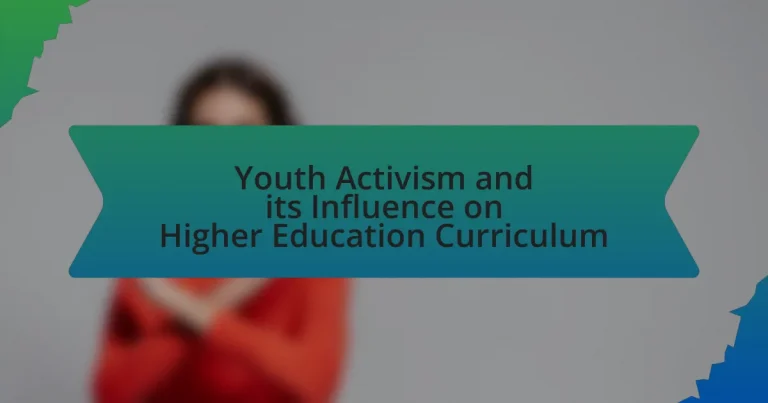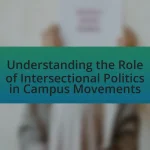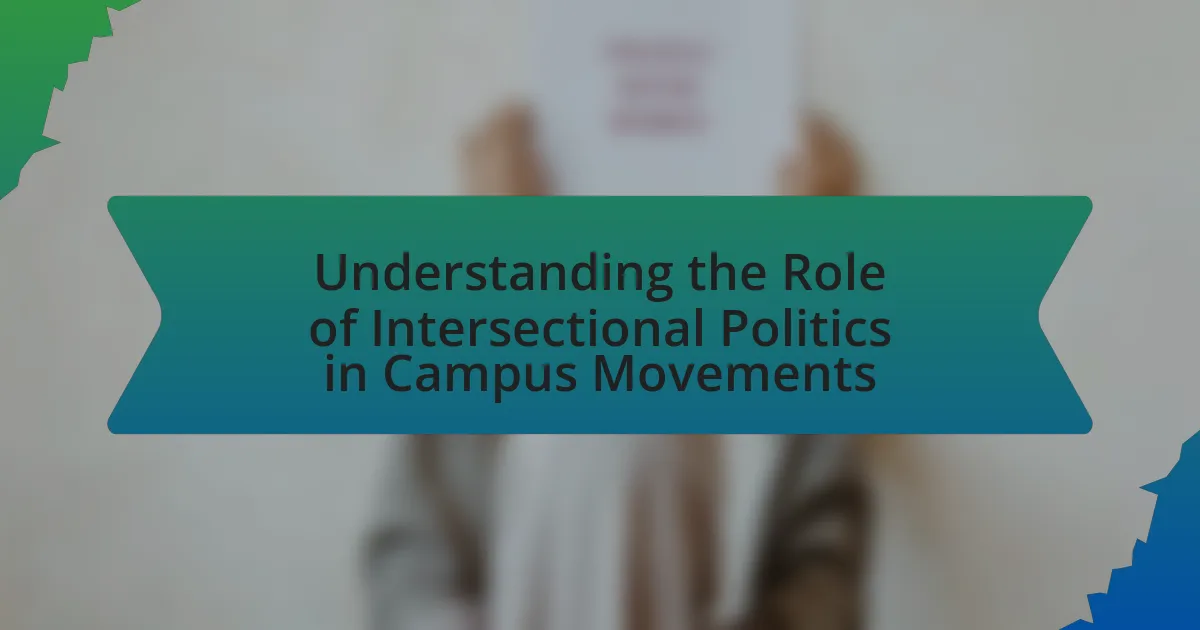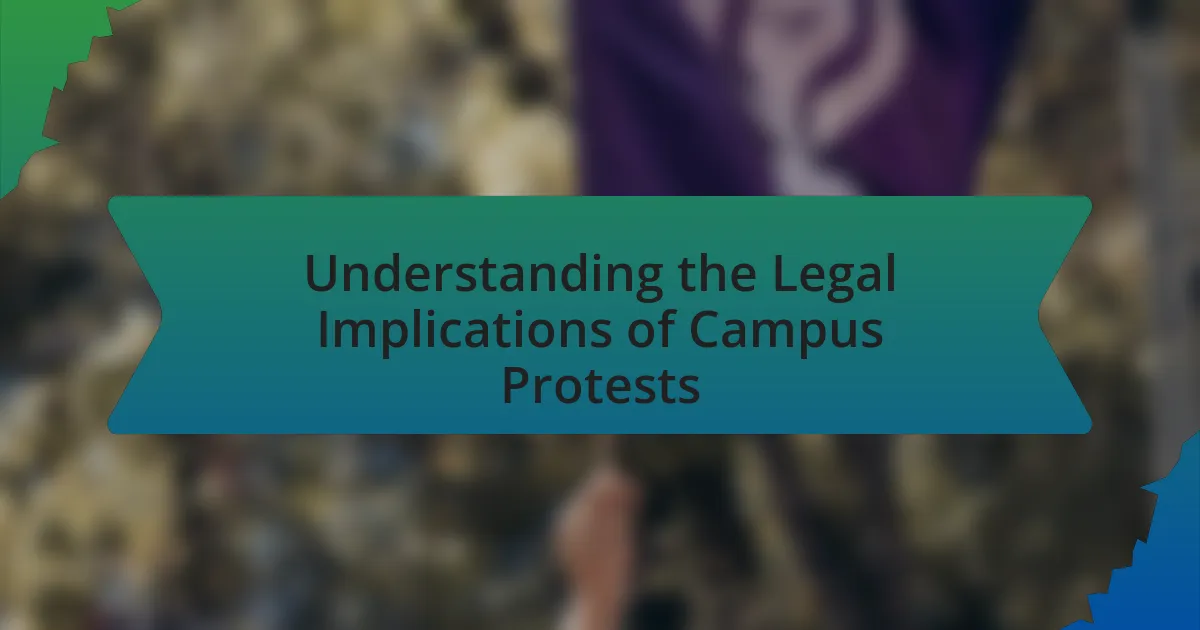Youth activism is the engagement of young individuals in social, political, and environmental issues to advocate for change, significantly influencing higher education curricula. This article examines how youth activism has historically impacted educational systems, highlighting key movements such as the Civil Rights Movement and the feminist movement that have driven reforms in curriculum and policy. It discusses the role of youth activists in shaping contemporary educational practices, promoting diversity and inclusion, and addressing current societal issues through innovative course offerings. Additionally, the article explores the challenges educational institutions face in responding to youth activism and the strategies activists employ to effect change in higher education.

What is Youth Activism and its Influence on Higher Education Curriculum?
Youth activism refers to the engagement of young people in social, political, and environmental issues to advocate for change. This form of activism significantly influences higher education curriculum by prompting institutions to incorporate contemporary social issues, such as climate change, racial justice, and gender equality, into their academic programs. For instance, universities have begun to offer courses that reflect the priorities of youth activists, such as sustainability studies and social justice education, which align with the interests and demands of younger generations. This shift is evidenced by the increasing number of student-led initiatives and organizations that advocate for curriculum reform, demonstrating that youth activism not only shapes educational content but also fosters a more inclusive and responsive academic environment.
How has youth activism historically impacted educational systems?
Youth activism has historically impacted educational systems by driving significant reforms and changes in curricula, policies, and access to education. For instance, during the Civil Rights Movement in the 1960s, student-led protests and sit-ins, such as those organized by the Student Nonviolent Coordinating Committee, led to the desegregation of schools and increased enrollment of African American students in higher education institutions. Additionally, the anti-war protests of the late 1960s and early 1970s prompted universities to reevaluate their roles in society, leading to the establishment of more inclusive and diverse academic programs. These movements not only influenced policy changes but also shaped the educational landscape by advocating for social justice, equity, and representation within curricula.
What key movements have shaped higher education through youth activism?
Key movements that have shaped higher education through youth activism include the Civil Rights Movement, the anti-Vietnam War protests, and the feminist movement. The Civil Rights Movement, particularly in the 1960s, led to significant changes in university policies regarding racial equality and access, exemplified by the establishment of programs aimed at increasing diversity. The anti-Vietnam War protests mobilized students across campuses, resulting in a greater emphasis on social justice and political engagement within academic curricula. The feminist movement also played a crucial role, advocating for gender equality in education and the inclusion of women’s studies programs, which transformed the landscape of higher education. These movements collectively influenced institutional policies, curriculum development, and the overall educational experience, demonstrating the power of youth activism in shaping higher education.
How do historical events influence current educational policies?
Historical events significantly shape current educational policies by providing context and rationale for reforms and curriculum changes. For instance, the civil rights movement in the 1960s led to the implementation of policies promoting diversity and inclusion in educational institutions, as seen in the establishment of affirmative action programs. These programs aimed to rectify historical inequalities and have influenced contemporary discussions on equity in education. Additionally, events such as the feminist movement have prompted the integration of gender studies into higher education curricula, reflecting societal shifts towards gender equality. Such historical precedents demonstrate how past struggles and achievements inform the frameworks and priorities of modern educational policies.
Why is youth activism important in shaping curriculum?
Youth activism is important in shaping curriculum because it brings the perspectives and needs of younger generations directly into educational frameworks. This involvement ensures that the curriculum remains relevant and responsive to contemporary social issues, such as climate change, social justice, and equity. For instance, movements like the March for Our Lives and Fridays for Future have successfully influenced educational institutions to incorporate discussions on gun control and environmental sustainability into their programs. By advocating for these changes, youth activists not only highlight pressing concerns but also foster critical thinking and civic engagement among their peers, ultimately leading to a more informed and active student body.
What role do young activists play in curriculum development?
Young activists play a crucial role in curriculum development by advocating for the inclusion of contemporary social issues and diverse perspectives in educational content. Their engagement often leads to the integration of topics such as climate change, social justice, and equity into curricula, reflecting the values and concerns of younger generations. For instance, movements led by young activists have prompted universities to revise their programs to include sustainability studies, demonstrating a direct influence on academic offerings. This shift not only aligns educational institutions with current societal needs but also empowers students to engage critically with relevant issues, fostering a more inclusive and responsive educational environment.
How does youth activism reflect societal changes in education?
Youth activism reflects societal changes in education by advocating for reforms that address issues such as equity, inclusivity, and mental health. This activism has led to significant shifts in educational policies and curricula, as seen in movements like the March for Our Lives, which emphasizes gun control and safety in schools, prompting discussions on mental health resources and safety protocols in educational institutions. Additionally, the Black Lives Matter movement has influenced educational content, pushing for the inclusion of diverse perspectives and histories in curricula, thereby reshaping how history and social studies are taught. These movements demonstrate that youth activism not only highlights existing societal issues but also drives educational institutions to adapt and respond to the evolving needs and values of society.
What are the main areas of influence of youth activism on higher education?
Youth activism significantly influences higher education in three main areas: curriculum development, policy reform, and campus culture. Firstly, youth activism drives curriculum development by advocating for the inclusion of social justice, environmental issues, and diversity topics, which has been evidenced by various universities integrating these subjects into their programs following student-led initiatives. Secondly, youth activism impacts policy reform, as student movements have successfully lobbied for changes in institutional policies regarding mental health services, tuition fees, and campus safety, demonstrating the power of collective student action. Lastly, youth activism shapes campus culture by fostering a more inclusive and engaged community, as seen in the rise of student organizations and movements that promote dialogue around pressing social issues, thereby enhancing the overall educational experience.
Which subjects are most affected by youth activism?
Youth activism most significantly affects subjects such as environmental science, social justice, political science, and education. These areas are influenced by the mobilization of young people advocating for climate action, equity, policy reform, and educational reform. For instance, the global climate strikes led by youth activists like Greta Thunberg have heightened awareness and curriculum focus on environmental issues in educational institutions. Additionally, movements like Black Lives Matter have prompted discussions on social justice and equity within political science and education curricula, reflecting the urgent need for systemic change.
How does youth activism promote diversity and inclusion in curricula?
Youth activism promotes diversity and inclusion in curricula by advocating for the representation of marginalized voices and perspectives in educational content. Activists often mobilize to challenge traditional curricula that overlook or misrepresent diverse histories, cultures, and experiences. For instance, campaigns led by youth organizations have successfully influenced educational institutions to incorporate topics such as racial justice, gender equality, and rights into their programs. Research indicates that inclusive curricula not only enhance student engagement but also foster a more equitable learning environment, as evidenced by studies showing improved academic outcomes for students from diverse backgrounds when their identities are reflected in their education.
How does youth activism connect to contemporary educational practices?
Youth activism significantly influences contemporary educational practices by promoting critical thinking, civic engagement, and social justice within curricula. Educational institutions increasingly incorporate themes of activism to empower students, encouraging them to engage with real-world issues such as climate change, racial equality, and mental health. For instance, the integration of service-learning projects and participatory action research in higher education allows students to apply their knowledge in community contexts, fostering a sense of responsibility and agency. Research by the Center for Information & Research on Civic Learning and Engagement indicates that students involved in civic activities are more likely to develop skills that enhance their academic performance and future employability. This connection between youth activism and education not only enriches the learning experience but also prepares students to become informed and active citizens.
What challenges do educational institutions face in responding to youth activism?
Educational institutions face significant challenges in responding to youth activism, primarily due to institutional inertia, conflicting stakeholder interests, and resource limitations. Institutional inertia often results in slow adaptation to the rapidly changing social and political landscape that youth activism represents, making it difficult for schools to implement timely changes. Conflicting stakeholder interests, including those of faculty, administration, and external community members, can lead to disagreements on how to address activist demands, complicating decision-making processes. Additionally, resource limitations, such as funding and personnel, hinder the ability of educational institutions to effectively engage with and support youth-led initiatives. These challenges are evident in various case studies, such as the response of universities to climate activism, where institutions struggled to balance financial commitments with student demands for sustainability initiatives.

What strategies do youth activists use to influence higher education curriculum?
Youth activists employ various strategies to influence higher education curriculum, including advocacy campaigns, coalition building, and direct engagement with educational institutions. Advocacy campaigns often involve organizing protests, petitions, and social media initiatives to raise awareness about specific issues, such as climate change or social justice, thereby pressuring universities to adopt relevant courses. Coalition building among different student organizations amplifies their voice, allowing for a unified front that can effectively lobby for curriculum changes. Direct engagement includes participating in curriculum committees, presenting research, and collaborating with faculty to develop new courses that reflect the interests and needs of the student body. These strategies have been shown to lead to tangible changes in curriculum, as evidenced by numerous universities incorporating student-led initiatives into their academic offerings.
How do social media platforms amplify youth activism in education?
Social media platforms amplify youth activism in education by providing a space for young people to organize, share information, and mobilize support for educational reforms. These platforms enable rapid dissemination of ideas and facilitate connections among like-minded individuals, which enhances collective action. For instance, movements like #BlackLivesMatter and #MeToo have utilized social media to raise awareness about systemic issues in education, leading to increased public discourse and institutional responses. Research indicates that 70% of young activists believe social media is crucial for their advocacy efforts, highlighting its role in shaping educational policies and practices.
What are the most effective social media campaigns led by youth activists?
The most effective social media campaigns led by youth activists include the #FridaysForFuture movement, initiated by Greta Thunberg, which mobilized millions globally to demand action on climate change. This campaign effectively utilized platforms like Twitter and Instagram to raise awareness and organize climate strikes, resulting in significant media coverage and political engagement. Another impactful campaign is the #NeverAgain movement, started by survivors of the Parkland shooting, which advocated for gun control and successfully influenced legislation in several states. These campaigns demonstrate the power of youth activism in shaping public discourse and policy through strategic social media engagement.
How do online petitions and campaigns impact curriculum changes?
Online petitions and campaigns significantly influence curriculum changes by mobilizing public support and drawing attention to specific educational issues. These digital tools allow students and community members to express their demands for curriculum reform, often leading educational institutions to reconsider their offerings. For instance, a notable example is the 2020 petition advocating for the inclusion of Black history in school curricula, which garnered over 300,000 signatures and prompted several universities to revise their programs. This demonstrates that the collective voice of activists can effectively pressure institutions to adapt their curricula in response to societal needs and values.
What role do student organizations play in advocating for curriculum changes?
Student organizations play a crucial role in advocating for curriculum changes by representing the collective voice of students and influencing academic policies. These organizations mobilize students to express their needs and preferences regarding educational content, often conducting surveys and organizing forums to gather input. For instance, the National Student Association has historically been instrumental in pushing for reforms that reflect student interests, such as the inclusion of diverse perspectives in course offerings. Their advocacy efforts can lead to formal proposals presented to academic committees, demonstrating the impact of organized student activism on curriculum development.
How do student-led initiatives shape educational policies?
Student-led initiatives shape educational policies by actively engaging students in advocacy efforts that influence decision-making processes within educational institutions. These initiatives often highlight issues such as diversity, mental health, and sustainability, prompting institutions to reconsider and revise their policies to better align with student needs and societal expectations. For instance, the student-led movement for mental health awareness has led universities to implement comprehensive mental health services and policies, reflecting the growing recognition of mental health as a critical component of student well-being. Additionally, research from the National Student Campaign Against Hunger and Homelessness indicates that student activism has successfully influenced policies related to food security and housing stability on campuses, demonstrating the tangible impact of student-led efforts on educational policy reform.
What are examples of successful student-led curriculum reforms?
Successful student-led curriculum reforms include the implementation of Ethnic Studies programs at various universities, such as San Francisco State University, which began in the late 1960s following student protests advocating for representation of marginalized communities in the curriculum. Another example is the push for more inclusive and diverse course offerings at the University of California, where student activism led to the establishment of a Black Studies department in the 1970s. Additionally, the student-led movement for sustainability education at institutions like the University of Michigan has resulted in the integration of environmental studies into the core curriculum, reflecting students’ demands for addressing climate change. These reforms demonstrate the significant impact of student activism on shaping educational content to be more inclusive and relevant.
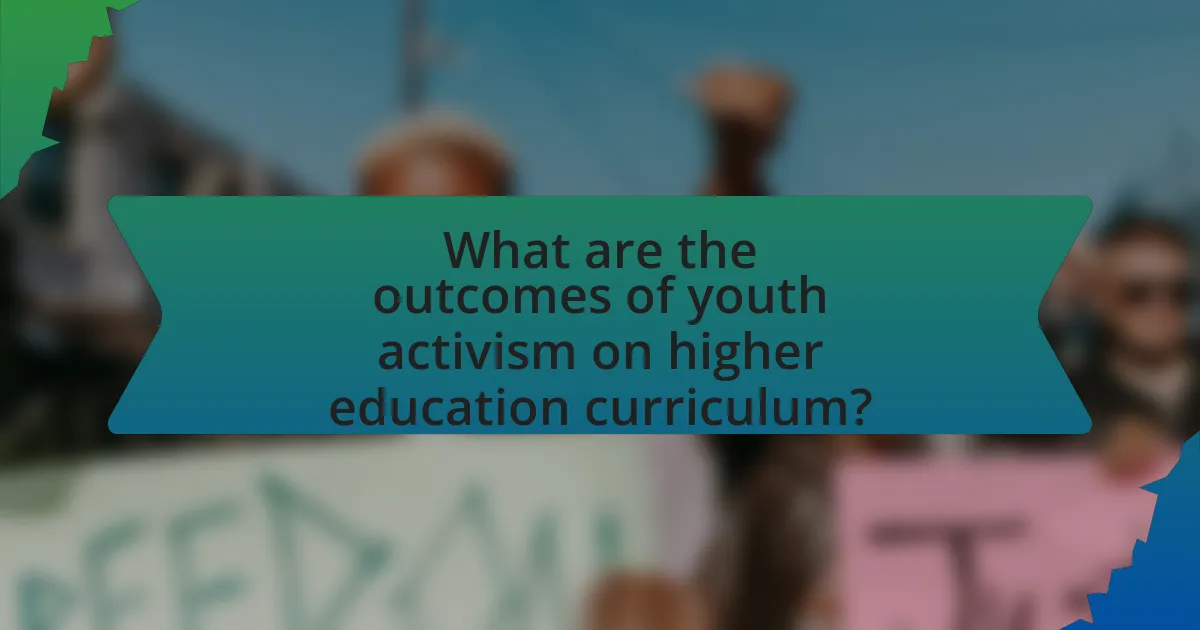
What are the outcomes of youth activism on higher education curriculum?
Youth activism significantly influences higher education curriculum by promoting inclusivity and social justice. This activism often leads to the incorporation of diverse perspectives and critical discussions on issues such as race, gender, and environmental sustainability within academic programs. For instance, movements like Black Lives Matter have prompted universities to revise their curricula to include more comprehensive studies on systemic racism and its historical context. Additionally, youth-led initiatives have resulted in the establishment of courses focused on climate change and social responsibility, reflecting the urgent concerns of younger generations. These changes are supported by research indicating that curricula responsive to student activism enhance engagement and learning outcomes, as seen in studies published by the Journal of Higher Education.
How does youth activism lead to curriculum innovation?
Youth activism leads to curriculum innovation by advocating for relevant social issues that reflect the values and needs of contemporary society. When young activists mobilize around topics such as climate change, social justice, or mental health, educational institutions often respond by integrating these themes into their curricula to remain relevant and engage students effectively. For instance, the rise of climate activism has prompted universities to develop courses focused on sustainability and environmental science, reflecting the urgency of the issue as highlighted by movements like Fridays for Future. This alignment between activism and curriculum development not only enhances educational relevance but also empowers students to engage critically with pressing global challenges.
What new subjects or courses have emerged from youth activism?
New subjects and courses that have emerged from youth activism include Environmental Justice, Social Movements, and Intersectional Feminism. These courses reflect the growing demand for education that addresses contemporary social issues driven by youth-led initiatives. For instance, Environmental Justice courses focus on the disproportionate impact of environmental policies on marginalized communities, a topic highlighted by youth activists during climate strikes. Similarly, Social Movements courses analyze the strategies and impacts of various youth-led movements, such as Black Lives Matter, which has gained significant traction in academic discussions. Intersectional Feminism courses explore the interconnectedness of gender, race, and class, responding to calls from young activists for a more inclusive feminist discourse. These subjects are increasingly integrated into higher education curricula, demonstrating the influence of youth activism on academic offerings.
How do these innovations address current societal issues?
Innovations in youth activism address current societal issues by integrating social justice themes into higher education curricula. This integration fosters critical thinking and awareness among students regarding pressing issues such as climate change, racial inequality, and mental health. For instance, universities that incorporate courses on social movements and activism equip students with the knowledge and skills to engage in societal change, as evidenced by programs at institutions like the University of California, which has seen increased student participation in activism-related initiatives. This educational approach not only empowers students but also encourages them to become active participants in addressing societal challenges, thereby creating a more informed and engaged citizenry.
What are the long-term effects of youth activism on educational institutions?
Youth activism has significant long-term effects on educational institutions, primarily by fostering curriculum changes and promoting inclusivity. Educational institutions often adapt their curricula to reflect the social issues raised by youth activists, such as climate change, social justice, and equity. For instance, the incorporation of environmental studies and social justice courses in many universities can be traced back to student-led movements advocating for these subjects. Research indicates that institutions responding to youth activism not only enhance student engagement but also improve retention rates, as students feel their voices are heard and valued. Furthermore, youth activism encourages the establishment of diverse student organizations and support systems, which contribute to a more inclusive campus environment. This evolution in educational practices demonstrates the profound impact of youth activism on shaping the future of higher education.
How do changes in curriculum affect student engagement and success?
Changes in curriculum significantly enhance student engagement and success by aligning educational content with students’ interests and societal issues. When curricula incorporate relevant topics, such as social justice and environmental sustainability, students are more likely to feel connected to their learning, which increases motivation and participation. Research indicates that active learning strategies, often introduced through curriculum changes, lead to higher retention rates and improved academic performance. For instance, a study published in the Journal of Educational Psychology found that students exposed to a curriculum emphasizing collaborative projects and real-world applications demonstrated a 20% increase in engagement levels compared to traditional lecture-based approaches. This evidence supports the notion that responsive curriculum changes foster a more engaging and successful educational environment.
What impact does youth activism have on faculty and administration perspectives?
Youth activism significantly influences faculty and administration perspectives by prompting a reevaluation of institutional policies and curricula. Faculty members often respond to youth activism by integrating contemporary social issues into their teaching, reflecting the concerns raised by students. For instance, the rise of movements such as Black Lives Matter has led many educators to incorporate discussions on racial justice into their courses, thereby aligning academic content with student activism. Administrators, in turn, may feel pressured to adopt more inclusive policies and practices, as seen in universities that have implemented diversity training and revised codes of conduct in response to student-led initiatives. This dynamic illustrates how youth activism serves as a catalyst for change within higher education, compelling both faculty and administration to adapt to the evolving demands of their student bodies.
What best practices can youth activists adopt to effectively influence curriculum?
Youth activists can effectively influence curriculum by engaging in collaborative dialogue with educational stakeholders, including faculty, administration, and fellow students. This approach fosters mutual understanding and allows activists to present their perspectives and needs clearly. Research indicates that student-led initiatives, such as petitions and organized forums, can lead to significant curriculum changes; for example, the University of California system saw increased ethnic studies courses after student advocacy efforts in the 1990s. Additionally, utilizing data and case studies to support their arguments enhances the credibility of youth activists’ proposals, making it more likely for educational institutions to consider their recommendations seriously.
